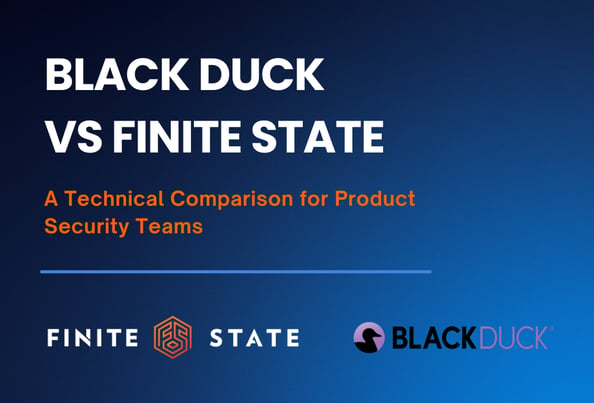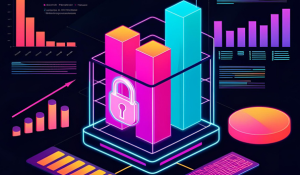When it comes to securing the software supply chain, not all tools are created equal, especially for manufacturers building connected devices. While Mend.io (formerly WhiteSource) is a strong player in the open-source security and license compliance space, it wasn’t built with embedded systems or regulatory complexity in mind. Finite State, by contrast, was purpose-built for the unique challenges of IoT, OT, and firmware-heavy environments.
Here’s a closer look at how the two platforms compare—and when Finite State may be the better fit for your organization.
Quick Snapshot: How They Stack Up
|
Category |
Mend.io |
Finite State |
|
Core Focus |
Developer-centric SCA for open source |
Software supply chain security for connected products |
|
Source Code SCA |
✔️ Strong |
✔️ Supported |
|
Binary/Firmware Analysis |
❌ Not supported |
✔️ Deep binary SCA, SAST, and firmware unpacking |
|
SBOM Management |
Basic generation |
Full lifecycle SBOM generation, ingestion, validation, and compliance reporting |
|
Compliance Support |
Minimal |
Designed for FDA, NIST, EU CRA, CE RED, and more |
|
Use Case Fit |
Modern SaaS, agile teams |
IoT, embedded systems, regulated industries |
|
Automation & DevOps |
Excellent IDE/CI/CD integration |
CI/CD support plus firmware workflows and CLI tools |
|
Remediation |
Auto-remediation for open source dependencies |
Actionable remediation across source, binary, and third-party software |
Where Mend.io Excels
Mend.io has earned its reputation as a leader in open-source vulnerability and license management. Originally founded as WhiteSource, its evolution into Mend.io reflects a strong focus on automation and developer enablement. Its platform is purpose-built for modern software development teams that need fast, reliable insights into open source risk.
Broad Open-Source Coverage
Mend.io shines in ecosystems dominated by open-source libraries and fast-paced release cycles. With deep support for popular programming languages and package managers—like JavaScript, Python, Java, and .NET—Mend allows developers to scan codebases quickly and accurately during active development. It can parse project manifests, lock files, and source files to detect both direct and transitive dependencies.
This wide coverage, combined with policy enforcement features, gives organizations strong governance at scale. Teams can implement rules to restrict the use of risky licenses (e.g., GPL-3) or prevent deployment of components with critical vulnerabilities, without slowing down engineering velocity.
Shift-Left and DevOps Integration
Mend’s real differentiator is how tightly it integrates into developer workflows. It offers out-of-the-box integrations with CI/CD pipelines (GitHub Actions, GitLab CI, Jenkins, Azure DevOps), as well as IDEs like Visual Studio Code and IntelliJ. This means developers can identify and remediate vulnerabilities within the tools they already use, often before code is even committed.
In some cases, Mend can even generate automated pull requests with version updates for vulnerable dependencies, streamlining remediation and reducing mean time to resolution (MTTR).
Automation and Remediation Tools
The addition of Mend Renovate—an automated dependency update engine—has further cemented Mend’s reputation as a developer-friendly solution. Renovate can monitor repositories and automatically generate pull requests to upgrade outdated packages. Combined with Mend’s vulnerability intelligence, this helps ensure software stays secure and up-to-date with minimal manual effort.
Its policy engine also enables real-time enforcement of compliance and security controls, helping AppSec teams scale oversight without becoming bottlenecks.
Cohesive User Experience and Scalability
Mend's SaaS platform delivers a unified UI/UX across all modules, making it easier for teams to adopt and manage. The interface is intuitive, responsive, and designed with developer usability in mind—an area where legacy SCA tools have struggled. For enterprises managing large portfolios of applications, Mend’s cloud architecture offers the scalability and responsiveness needed to support complex environments.
Where Finite State Leads
Finite State was built from the ground up to secure software supply chains for connected and embedded devices. Its platform goes far beyond traditional SCA by offering deep analysis of binaries, firmware, and system-level software—capabilities that Mend.io does not support. For regulated industries, legacy products, and air-gapped environments, Finite State offers visibility and control that source-focused tools simply cannot match.
Comprehensive Binary and Firmware Analysis
Unlike Mend.io, which operates entirely at the source layer, Finite State can unpack, dissect, and analyze compiled binaries and firmware images. This is critical in embedded systems, where software is often a mix of open source, proprietary, and third-party components, and source code may be unavailable.
Finite State’s binary SCA and SAST capabilities go well beyond known CVEs. Its analysis can detect insecure coding patterns, cryptographic weaknesses, hardcoded credentials, and misconfigurations that would be invisible to tools limited to package manifests or source code.
This is a vital advantage for manufacturers relying on software of uncertain provenance, especially in supply chains involving third-party or vendor-supplied binaries.
SBOM Management Built for the Real World
Where Mend generates SBOMs primarily from source dependencies, Finite State enables full SBOM lifecycle management. This includes:
- Automated SBOM generation for source, binaries, and firmware—even without source access.
- SBOM ingestion from external vendors or tools to create a unified software inventory.
- Continuous monitoring for vulnerabilities across a device’s lifecycle.
- Distribution support for CycloneDX, SPDX, VEX, and VDR formats.
Finite State doesn’t just provide a snapshot; it maintains a living, auditable, and enriched SBOM across development and operational phases. This is particularly valuable for compliance with frameworks like the EU Cyber Resilience Act, CE RED, and the U.S. Cyber Trust Mark.
Embedded Compliance and Regulatory Readiness
Finite State stands out in its support for regulated industries, such as healthcare, automotive, aerospace, and critical infrastructure. Beyond generating vulnerability and license reports, it offers features and services aligned with:
- FDA 524B
- EU Cyber Resilience Act
- CE RED Article 3.3
- NIST 800-218 (SSDF)
- Executive Order 14028
This goes beyond “checkbox” compliance—Finite State helps organizations operationalize security policies, produce audit-ready reports, and confidently meet evolving requirements.
Integrated Risk Scoring and Prioritization
Finite State’s findings aren’t just about volume—they’re prioritized using contextual risk factors like exploit maturity, component exposure, and device role. This enables security teams to focus on what actually matters, reducing alert fatigue and accelerating remediation.
Combined with features like policy-driven build gating and integrated remediation guidance, Finite State is a powerful platform for not just identifying risk but also reducing it.
Hands-On Support and Embedded Expertise
Finite State doesn’t just offer a platform; it offers a partnership. Backed by government-grade expertise and a seasoned services team, Finite State delivers tailored guidance, policy consulting, penetration testing, and secure SDLC enablement for customers operating in complex environments.
For teams building regulated products or navigating multi-tier supply chains, this level of support can be the difference between meeting deadlines and failing audits.
When to Choose Mend.io
Mend.io is a smart, efficient solution for DevOps teams building modern web applications that rely heavily on open source. It’s best suited for:
- Cloud-native applications with full access to source code
- Organizations seeking fast CI/CD integration
- Teams focused on license compliance and automated remediation
If your primary concern is open-source risk in fast-paced, modern development workflows, and you don’t deal with compiled binaries, firmware, or regulated environments, Mend.io is a proven and developer-friendly tool that gets the job done.
When to Choose Finite State
While Mend.io provides excellent coverage for modern application development, Finite State is the better choice when your software lives in or touches a connected device, embedded system, or regulated environment.
Here’s when Finite State stands out:
You Need Visibility Beyond Source Code
If your product includes pre-compiled binaries, third-party firmware, or vendor-delivered software without access to source code, Mend.io simply won’t be able to help. Finite State can reverse-engineer and analyze these components using advanced binary SCA and SAST techniques to uncover:
- Vulnerabilities in proprietary and open-source components
- Misconfigurations in firmware images
- Hardcoded credentials and insecure cryptographic implementations
This is essential for IoT, automotive, healthcare, and industrial products where full-source access is rare.
You Must Comply with Industry-Specific Regulations
Finite State is purpose-built for compliance with regulatory frameworks like:
- FDA 524B for medical devices
- EU Cyber Resilience Act and CE RED
- U.S. Cyber Trust Mark
- NIST 800-218 SSDF
- Executive Order 14028
Finite State offers SBOM generation, policy enforcement, audit-ready reporting, and compliance tracking throughout the product lifecycle. If you’re preparing for audits or need to prove conformance, Finite State delivers.
You Want to Prioritize Risk Based on Exploitability
In security, context is everything. Finite State integrates exploit intelligence from over 200 sources, including known exploited vulnerabilities (KEV), ransomware indicators, and proof-of-concept exploits. This enables:
- Accurate risk scoring
- Actionable prioritization
- Reduced noise and alert fatigue
If you need to focus limited resources on the highest-impact vulnerabilities, Finite State’s data-driven approach makes it easier to cut through the noise.
You Manage Firmware or Connected Products Across a Long Lifecycle
Finite State helps you:
- Generate and enrich SBOMs for new and legacy devices
- Continuously monitor them for emerging threats
- Distribute enriched SBOMs in SPDX, CycloneDX, or VEX formats
- Validate fixes and perform remediation testing
This end-to-end coverage is especially critical when products have long support cycles, such as industrial controls, medical devices, or automotive ECUs.
You Want Expert Guidance Along the Way
From secure SDLC advisory to managed services and penetration testing, you can access government-grade expertise to help navigate technical and regulatory complexity.
If you're building products that go into regulated, embedded, or high-assurance environments, Finite State is the platform designed to meet your real-world needs.
Honest Takeaway
Mend.io is a mature, developer-friendly SCA platform. However, its strength in source-level dependency management is offset by a lack of firmware support, limited compliance guidance, and a narrow focus on agile dev environments.
Finite State doesn’t try to compete head-to-head on pure source scanning automation, but it doesn’t need to. It wins where complexity, embedded systems, and compliance requirements matter most.
Want to see how Finite State compares in a real-world scenario?
Request a demo to explore how we help manufacturers and product security teams go beyond the limitations of traditional SCA tools.
Subscribe to Our Blog
Get the latest posts delivered straight to your inbox weekly.
Share this
You May Also Like
These Related Stories

Black Duck vs Finite State: What’s the Best Software Composition Analysis (SCA) Tool?

The 2025 Verizon Data Breach Investigations Report: What It Means for Product and Supply Chain Security
%20(2).png?width=761&height=403&name=Blog%20header%20(300%20x%20175%20px)%20(2).png)

